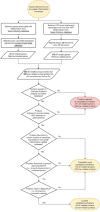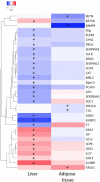Mechanism-Based Biomarker Prediction for Low-Grade Inflammation in Liver and Adipose Tissue
- PMID: 34858196
- PMCID: PMC8631400
- DOI: 10.3389/fphys.2021.703370
Mechanism-Based Biomarker Prediction for Low-Grade Inflammation in Liver and Adipose Tissue
Abstract
Metabolic disorders, such as obesity and type 2 diabetes have a large impact on global health, especially in industrialized countries. Tissue-specific chronic low-grade inflammation is a key contributor to complications in metabolic disorders. To support therapeutic approaches to these complications, it is crucial to gain a deeper understanding of the inflammatory dynamics and to monitor them on the individual level. To this end, blood-based biomarkers reflecting the tissue-specific inflammatory dynamics would be of great value. Here, we describe an in silico approach to select candidate biomarkers for tissue-specific inflammation by using a priori mechanistic knowledge from pathways and tissue-derived molecules. The workflow resulted in a list of candidate markers, in part consisting of literature confirmed biomarkers as well as a set of novel, more innovative biomarkers that reflect inflammation in the liver and adipose tissue. The first step of biomarker verification was on murine tissue gene-level by inducing hepatic inflammation and adipose tissue inflammation through a high-fat diet. Our data showed that in silico predicted hepatic markers had a strong correlation to hepatic inflammation in the absence of a relation to adipose tissue inflammation, while others had a strong correlation to adipose tissue inflammation in the absence of a relation to liver inflammation. Secondly, we evaluated the human translational value by performing a curation step in the literature using studies that describe the regulation of the markers in human, which identified 9 hepatic (such as Serum Amyloid A, Haptoglobin, and Interleukin 18 Binding Protein) and 2 adipose (Resistin and MMP-9) inflammatory biomarkers at the highest level of confirmation. Here, we identified and pre-clinically verified a set of in silico predicted biomarkers for liver and adipose tissue inflammation which can be of great value to study future development of therapeutic/lifestyle interventions to combat metabolic inflammatory complications.
Keywords: blood-based biomarker; lifestyle intervention; low-grade inflammation; mechanism; metabolic disease.
Copyright © 2021 van Bilsen, van den Brink, van den Hoek, Dulos, Caspers, Kleemann, Wopereis and Verschuren.
Conflict of interest statement
The authors declare that the research was conducted in the absence of any commercial or financial relationships that could be construed as a potential conflict of interest.
Figures





References
LinkOut - more resources
Full Text Sources
Miscellaneous

